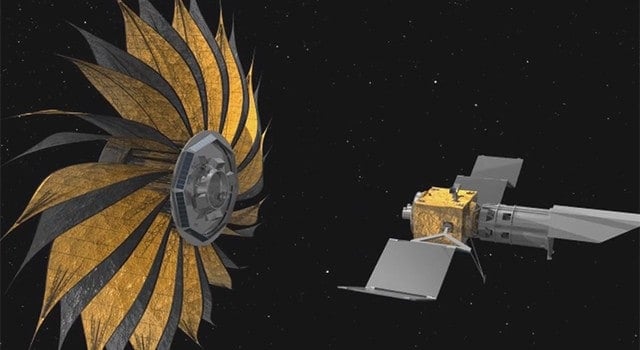A spacecraft that looks like a giant sunflower might one day be used to acquire images of Earth-like rocky planets around nearby stars. The prototype deployable structure, called a starshade, is being developed by NASA’s Jet Propulsion Laboratory in Pasadena, Calif.
The hunt is on for planets that resemble Earth in size, composition and temperature. Rocky planets with just the right temperature for liquid water — not too hot, not too cold — could be possible abodes for life outside our solar system. NASA’s Kepler mission has discovered hundreds of planets orbiting other stars, called exoplanets, some of which are a bit larger than Earth and lie in this comfortable “Goldilocks” zone.
Researchers generally think it’s only a matter of time before we find perfect twins of Earth. The next step would be to image and characterize their spectra, or chemical signatures, which provide clear clues about whether those worlds could support life. The starshade is designed to help take those pictures of planets by blocking out the overwhelmingly bright light of their stars. Simply put, the starshade is analogous to holding your hand up to the sun to block it while taking a picture of somebody.
The proposed starshade could launch together with a telescope. Once in space, it would separate from the rocket and telescope, unfurl its petals, then move into position to block the light of stars.
The project is led by Jeremy Kasdin, a professor at Princeton University, N.J., in conjunction with JPL and support from Northrop Grumman of Redondo Beach, Calif.
Kasdin gave a TED talk about the project on March 19. More information is at:
Read more about the Starshade at:
http://planetquest.jpl.nasa.gov/video/15
JPL manages NASA’s Exoplanet Exploration program office.
If our reporting has informed or inspired you, please consider making a donation. Every contribution, no matter the size, empowers us to continue delivering accurate, engaging, and trustworthy science and medical news. Independent journalism requires time, effort, and resources—your support ensures we can keep uncovering the stories that matter most to you.
Join us in making knowledge accessible and impactful. Thank you for standing with us!

